
W78C801
8-BIT MICROCONTROLLER
Publication Release Date: February 1999
- 1 -
Revision A3
GENERAL DESCRIPTION
The W78C801 is an 8-bit microcontroller which can accommodate a wide frequency range with low
power consumption. The instruction set for the W78C801 is fully compatible with the standard 8051.
The W78C801 contains an 4K bytes Mask ROM; a 256 bytes RAM; four 8-bit bi-directional and bit-
addressable I/O ports; an additional 6-bit I/O port P4; two 16-bit timer/counters; a hardware watchdog
timer. These peripherals are supported by a twelve sources two-level interrupt capability. The
W78C801 does not contain serial port.
The W78C801 microcontroller has two power reduction modes, idle mode and power-down mode,
both of which are software selectable. The idle mode turns off the processor clock but allows for
continued peripheral operation. The power-down mode stops the crystal oscillator for minimum power
consumption. The external clock can be stopped at any time and in any state without affecting the
processor.
FEATURES
∑
Fully static design 8-bit CMOS microcontroller
∑
DC-40 MHz operation
∑
256 bytes of on-chip scratchpad RAM
∑
4 KB Mask-ROM
∑
64 KB program memory address space
∑
64 KB data memory address space
∑
Four 8-bit bi-directional ports
∑
Two 16-bit timer/counters
∑
Watchdog Timer
∑
Direct LED drive outputs
∑
Twelve sources, two-level interrupt capability
∑
Wake-up via external interrupts at Port 1
∑
EMI reduction mode
∑
Built-in power management
∑
Code protection mechanism
∑
Packages:
-
DIP 40: W78C801-24/40
-
PLCC 44: W78C801P-24/40
-
PQFP 44: W78C801F-24/40

W78C801
- 2 -
PIN CONFIGURATIONS
VDD
1
2
3
4
5
6
7
8
9
10
11
12
13
14
15
16
17
18
19
20
39
40
34
35
36
37
38
30
31
32
33
26
27
28
29
21
22
23
24
25
P0.0, AD0
P0.1, AD1
P0.2, AD2
P0.3, AD3
P0.4, AD4
P0.5, AD5
P0.6, AD6
P0.7, AD7
EA
ALE,P4.5
PSEN,P4.6
P2.5, A13
P2.6, A14
P2.7, A15
P2.0, A8
P2.1, A9
P2.2, A10
P2.3, A11
P2.4, A12
INT2, P1.0
40-Pin DIP (W78C801)
INT4,P1.2
INT5,P1.3
INT6,P1.4
INT7,P1.5
INT8,P1.6
P3.0
P3.1
INT9,P1.7
RST
INT0, P3.2
INT1, P3.3
T0, P3.4
T1, P3.5
WR, P3.6
RD, P3.7
XTAL1
XTAL2
VSS
INT3, P1.1
44-Pin PLCC (W78C801P)
44-Pin QFP (W78C801F)
34
40 39 38 37 36 35
44 43 42 41
33
32
31
30
29
28
27
26
25
24
23
P0.4, AD4
P0.5, AD5
P0.6, AD6
P0.7, AD7
EA
ALE,P4.5
PSEN,P4.6
P2.7, A15
P2.6, A14
P2.5, A13
22
21
20
19
18
17
16
15
14
13
12
11
4
3
2
1
8
7
6
5
10
9
X
T
A
L
1
V
S
S
P
2
.
4
,
A
1
2
P
2
.
3
,
A
1
1
P
2
.
2
,
A
1
0
P
2
.
1
,
A
9
P
2
.
0
,
A
8
X
T
A
L
2
P
3
.
7
,
/
R
D
P
3
.
6
,
/
W
R
40
2 1 44 43 42 41
6 5
4 3
39
38
37
36
35
34
33
32
31
30
29
P0.4, AD4
P0.5, AD5
P0.6, AD6
P0.7, AD7
EA
ALE,P4.5
PSEN,P4.6
P2.7, A15
P2.6, A14
P2.5, A13
28
27
26
25
24
23
22
21
20
19
18
17
10
9
8
7
14
13
12
11
16
15
X
T
A
L
1
V
S
S
P
2
.
4
,
A
1
2
P
2
.
3
,
A
1
1
P
2
.
2
,
A
1
0
P
2
.
1
,
A
9
P
2
.
0
,
A
8
X
T
A
L
2
P
3
.
7
,
/
R
D
P
3
.
6
,
/
W
R
P
4
.
0
P4.1
P4.1
P
4
.
0
A
D
3
,
P
0
.
3
,
P
1
.
0
P
1
.
2
V
D
D
A
D
2
,
P
0
.
2
A
D
1
,
P
0
.
1
A
D
0
,
P
0
.
0
P
1
.
1
P
1
.
3
P
1
.
4
P
4
.
2
,
I
N
T
3
,
I
N
T
6
,
I
N
T
5
,
I
N
T
4
I
N
T
2
A
D
3
,
P
0
.
3
,
P
1
.
0
P
1
.
2
V
D
D
A
D
2
,
P
0
.
2
A
D
1
,
P
0
.
1
A
D
0
,
P
0
.
0
,
P
1
.
1
P
1
.
3
P
1
.
4
P
4
.
2
I
N
T
3
,
I
N
T
6
,
I
N
T
5
,
I
N
T
4
I
N
T
2
INT7,P1.5
INT8,P1.6
INT9,P1.7
RST
P3.0
P3.1
INT0, P3.2
INT1, P3.3
T0, P3.4
T1, P3.5
P4.3
INT7,P1.5
INT8,P1.6
INT9,P1.7
RST
P3.0
P3.1
INT0, P3.2
INT1, P3.3
T0, P3.4
T1, P3.5
P4.3

W78C801
Publication Release Date: February 1999
- 3 -
Revision A3
PIN DESCRIPTION
SYMBOL
DESCRIPTIONS
EA
EXTERNAL ACCESS ENABLE: This pin forces the processor to execute out of
external ROM. It should be kept high to access internal ROM. The ROM address and
data will not be presented on the bus if
EA
pin is high and the program counter is
within on-chip ROM area. Otherwise they will be presented on the bus.
PSEN
PROGRAM STORE ENABLE: PSEN enables the external ROM data onto the Port 0
address/ data bus during fetch and MOVC operations. When internal ROM access is
performed, no PSEN strobe signal outputs from this pin. This pin also serves the
alternative function P4.6.
ALE
ADDRESS LATCH ENABLE: ALE is used to enable the address latch that separates
the address from the data on Port 0. This pin also serves the alternative function P4.5
RST
RESET: A high on this pin for two machine cycles while the oscillator is running resets
the device.
XTAL1
CRYSTAL1: This is the crystal oscillator input. This pin may be driven by an external
clock.
XTAL2
CRYSTAL2: This is the crystal oscillator output. It is the inversion of XTAL1.
V
SS
GROUND: Ground potential
V
DD
POWER SUPPLY: Supply voltage for operation.
P0.0
-
P0.7 PORT 0: Port 0 is a bi-directional I/O port which also provides a multiplexed low order
address/data bus during accesses to external memory. The pins of Port 0 can be
individually configured to open-drain or standard port with internal pull-ups.
P1.0
-
P1.7 PORT 1: Port 1 is a bi-directional I/O port with internal pull-ups. The bits have alternate
functions which are described below:
INT2
-
INT9(P1.0
-
P1.7): External interrupt 2 to 9
P2.0
-
P2.7 PORT 2: Port 2 is a bi-directional I/O port with internal pull-ups. This port also provides
the upper address bits for accesses to external memory.
P3.0
-
P3.7 PORT 3: Port 3 is a bi-directional I/O port with internal pull-ups. The pins P3.4 to P3.7
can be configured with high sink current which can drive LED displays directly. All bits
have alternate functions, which are described below:
INT0 (P3.2) : External Interrupt 0
INT1
(P3.3) : External Interrupt 1
T0(P3.4) : Timer 0 External Input
T1(P3.5) : Timer 1 External Input
WR
(P3.6) : External Data Memory Write Strobe
RD
(P3.7) : External Data Memory Read Strobe
P4.0
-
P4.6 PORT 4: A 6-bit bi-directional I/O port which is bit-addressable. Pins P4.0 to P4.3 are
available on 44-pin PLCC/QFP package. Pins P4.5 and P4.6 are the alternative
function corresponding to ALE and PSEN.
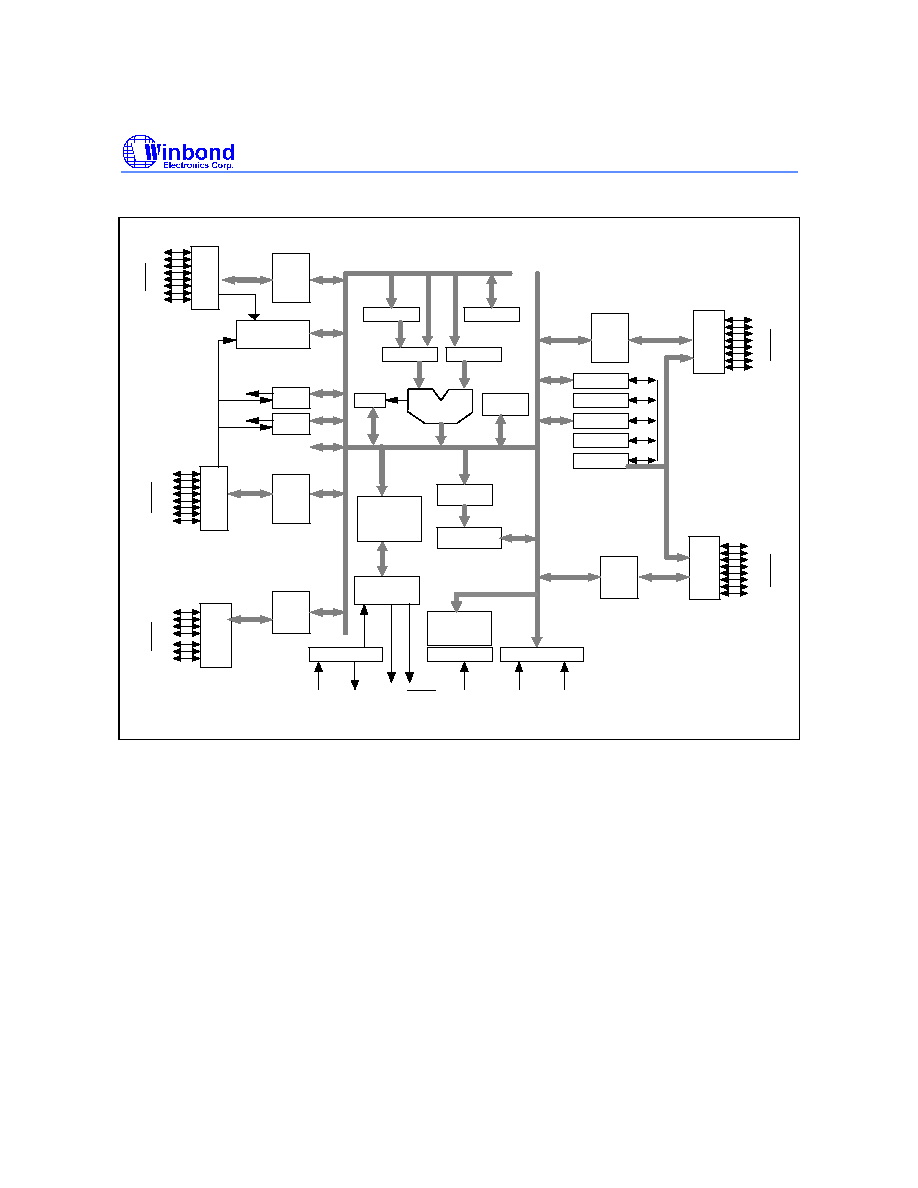
W78C801
- 4 -
BLOCK DIAGRAM
P3.0
P3.7
P1.0
P1.7
ALU
Port 0
Latch
Port 1
Latch
Timer
1
Timer
0
Port
1
XTAL1
PSEN
ALE
Vss
VCC
RST
XTAL2
Oscillator
Interrupt
PSW
Instruction
Decoder
&
Sequencer
Reset Block
Bus & Clock
Controller
SFR RAM
Address
Power control
256 bytes
RAM & SFR
Stack
Pointer
B
Addr. Reg.
Incrementor
PC
DPTR
Temp Reg.
T2
T1
ACC
Port 3
Latch
Port 4
Latch
Port
3
Port 2
Latch
P4.0
P4.6
Port
4
Port
0
Port
2
P2.0
P2.7
P0.0
P0.7
INT2~9
Watchdog
Timer
FUNCTIONAL DESCRIPTION
The W78C801 architecture consists of a core controller surrounded by various registers, five general
purpose I/O ports, 256 bytes of RAM, two timer/counters. The processor supports 111 different
opcodes and references both a 64K program address space and a 64K data storage space.
Timers 0, 1
Timers 0, 1 each consist of two 8-bit data registers. These are called TL0 and TH0 for Timer 0, TL1
and TH1 for Timer 1. The TCON and TMOD registers provide control functions for timers 0 and 1.
The operations of Timer 0 and Timer 1 are the same as in the W78C51.
I/O Port Options
The Port 0 and Port 3 of W78C801 may be configured with different types by setting the bits of the
Port Options Register POR that is located at 86H. The pins of Port 0 can be configured with either the
open drain or standard port with internal pull-up. By the default, Port 0 is an open drain bi-directional
I/O port. When the PUP bit in the POR register is set, the pins of Port 0 will perform a quasi-bi-
directional I/O port with internal pull-up that is structurally the same as Port 2. The high nibble of Port

W78C801
Publication Release Date: February 1999
- 5 -
Revision A3
3 (P3.4 to P3.7) can be selected to serve the direct LED displays drive outputs by setting the HDx bit
in the PO register. When the HDx bit is set, the corresponding pin P3.x can sink about 20mA current
for driving LED display directly. After reset, the POR register is cleared and the pins of Ports 0 and 3
are the same as those of the standard 80C31. The POR register is shown below.
Port Options Register
Bit:
7
6
5
4
3
2
1
0
EP6
EP5
-
HD7
HD6
HD5
HD4
PUP
Mnemonic: POR
Address: 86H
PUP : Enable Port 0 weak pull-up.
HD4-7: Enable pins P3.4 to P3.7 individually with High Drive outputs.
EP5 : Enable P4.5. To set this bit shifts ALE pin to the alternate function P4.5.
EP6 : Enable P4.6. To set this bit shifts PSEN pin to the alternate function P4.6
Port 4
The W78C801 has one additional bit-addressable I/O port P4 in which the port address is D8H. The
Port 4 contains seven bits; P4.0 to P4.3 are only available on 44-pin PLCC/QFP package; P4.5 and
P4.6 are the alternate function corresponding to pins ALE, PSEN . When program is running in the
internal memory without any access to external memory, ALE and PSEN may be individually
configured to the alternate functions P4.5 and P4.6 that serve as general purpose I/O pins. To enable
I/O port P4.5 and P4.6, the bits EP5 and EP6 in the POR register must be set. During reset, the ALE
and PSEN perform as in the standard 80C32. The alternate functions P4.5 and P4.6 must be
enabled by software. Care must be taken with the ALE pins when configured as the alternate
functions. The ALE will emit pulses until either the EP5 bit in POR register or AO bit in AUXR register
is set to 1. i.e. User's applications should elude the ALE pulses before software configure it with I/O
port P4.5.
Port 4
Bit:
7
6
5
4
3
2
1
0
-
P4.6
P4.5
-
P4.3
P4.2
P4.1
P4.0
Mnemonic: P4
Address: D8H
Interrupt System
The W78C801 has twelve interrupt sources: INT0 and
INT1
; Timer 0,1; INT2 to INT9. Each interrupt
vectors to a specific location in program memory for its interrupt service routine. Each of these
sources can be individually enabled or disabled by setting or clearing the corresponding bit in Special
Function Register IE0 and IE1. The individual interrupt priority level depends on the Interrupt Priority
Register IP0 and IP1. Additional external interrupts INT2 to INT9 are level sensitive and may be used
to awake the device from power down mode. The Port 1 interrupts can be initialized to either active
HIGH or LOW via setting the Interrupt Polarity Register IX. The IRQ register contains the flags of Port
1 interrupts. Each flag in IRQ register will be set when an interrupt request is recognized but
must be
cleared by software. Note that the interrupt flags have to be cleared before the interrupt service
routine is completed, or else another interrupt will be generated.
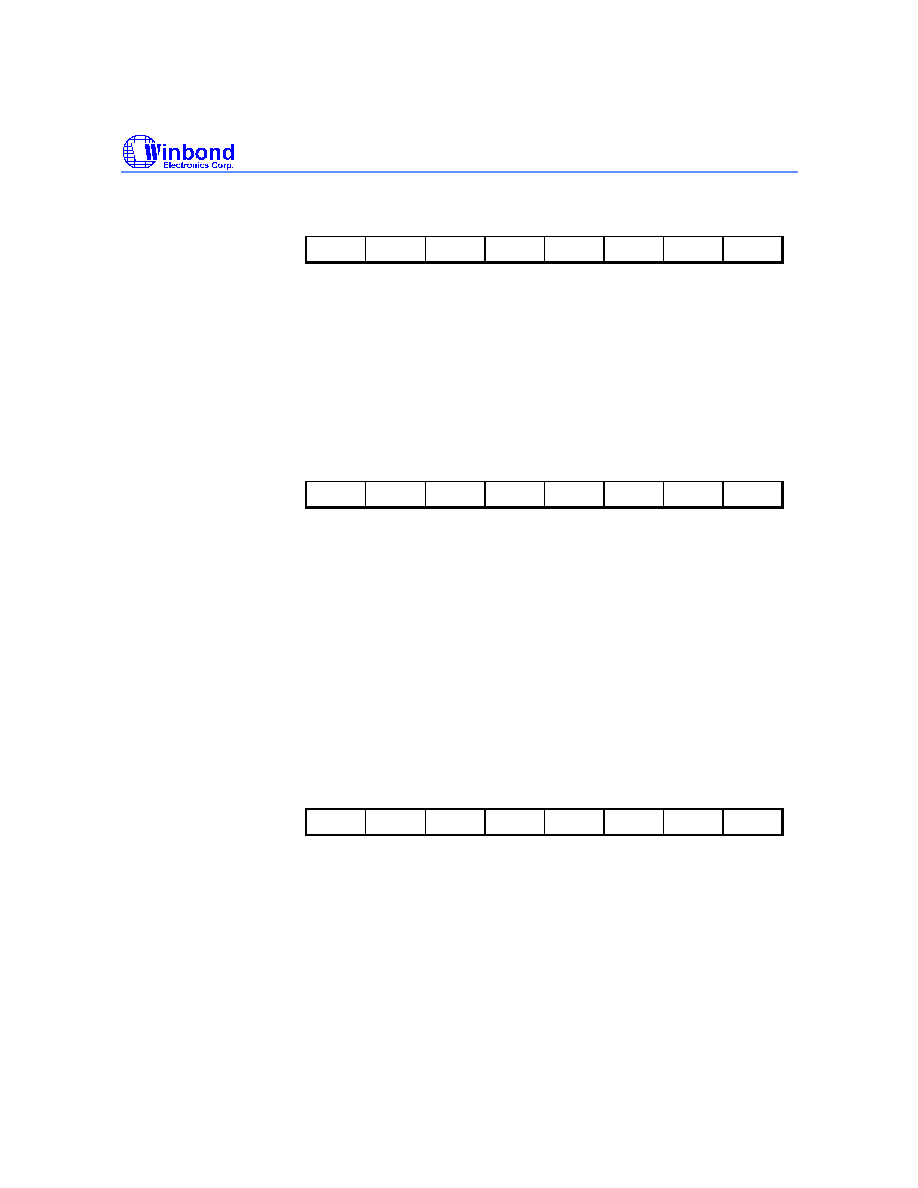
W78C801
- 6 -
Interrupt Enable Register 0
Bit:
7
6
5
4
3
2
1
0
EA
-
-
-
ET1
EX1
ET0
EX0
Mnemonic: IE
Address: A8H
EA : Global enable. Enable/disable all interrupts.
ET1: Enable Timer 1 interrupt
EX1: Enable external interrupt 1
ET0: Enable Timer 0 interrupt
EX0: Enable external interrupt 0
Interrupt Enable Register 1
Bit:
7
6
5
4
3
2
1
0
EX9
EX8
EX7
EX6
EX5
EX4
EX3
EX2
Mnemonic: IE1
Address: E8H
EX9: Enable external interrupt 9
EX8: Enable external interrupt 8
EX7: Enable external interrupt 7
EX6: Enable external interrupt 6
EX5: Enable external interrupt 5
EX4: Enable external interrupt 4
EX3: Enable external interrupt 3
EX2: Enable external interrupt 2
Note: 0 = interrupt disabled, 1 = interrupt enabled.
Interrupt Priority Register 0
Bit:
7
6
5
4
3
2
1
0
-
PS1
PT2
PS
PT1
PX1
PT0
PX0
Mnemonic: IP0
Address: B8h
IP.7: Unused.
PS1: This bit defines the Serial port 1 interrupt priority. PS = 1 sets it to higher priority level.
PT2: This bit defines the Timer 2 interrupt priority. PT2 = 1 sets it to higher priority level.
PS : This bit defines the Serial port 0 interrupt priority. PS = 1 sets it to higher priority level.
PT1: This bit defines the Timer 1 interrupt priority. PT1 = 1 sets it to higher priority level.
PX1: This bit defines the External interrupt 1 priority. PX1 = 1 sets it to higher priority level.
PT0: This bit defines the Timer 0 interrupt priority. PT0 = 1 sets it to higher priority level.
PX0: This bit defines the External interrupt 0 priority. PX0 = 1 sets it to higher priority level.
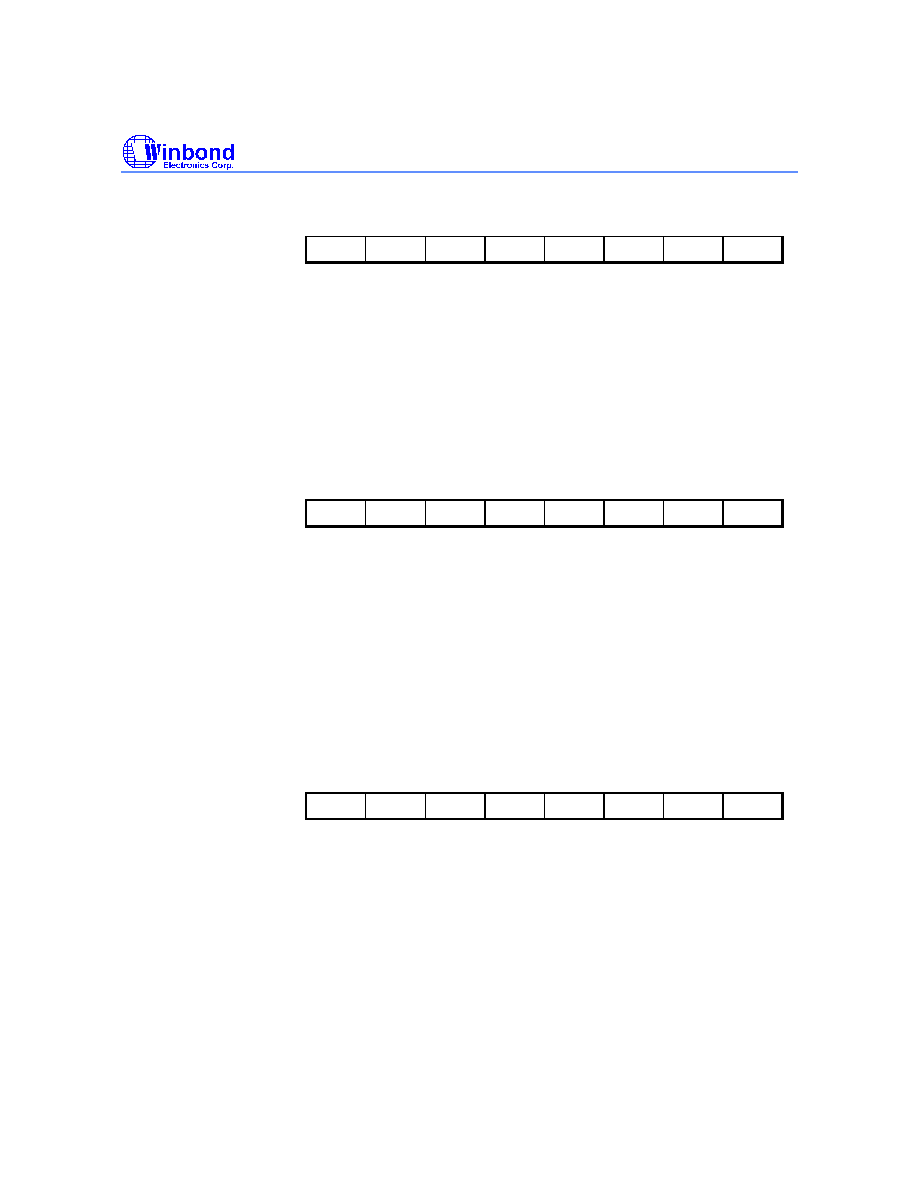
W78C801
Publication Release Date: February 1999
- 7 -
Revision A3
Interrupt Priority Register 1
Bit:
7
6
5
4
3
2
1
0
PX9
PX8
PX7
PX6
PX5
PX4
PX3
PX2
Mnemonic: IP1
Address: F8h
PX9: This bit defines the External interrupt 9 priority. PX9 = 1 sets it to higher priority level.
PX8: This bit defines the External interrupt 8 priority. PX8 = 1 sets it to higher priority level.
PX7: This bit defines the External interrupt 7 priority. PX7 = 1 sets it to higher priority level.
PX6: This bit defines the External interrupt 6 priority. PX6 = 1 sets it to higher priority level.
PX5: This bit defines the External interrupt 5 priority. PX5 = 1 sets it to higher priority level.
PX4: This bit defines the External interrupt 4 priority. PX4 = 1 sets it to higher priority level.
PX3: This bit defines the External interrupt 3 priority. PX3 = 1 sets it to higher priority level.
PX2: This bit defines the External interrupt 2 priority. PX2 = 1 sets it to higher priority level.
Interrupt Polarity Register
Bit:
7
6
5
4
3
2
1
0
IL9
IL8
IL7
IL6
IL5
IL4
IL3
IL2
Mnemonic: IX
Address: E9H
IL9: External interrupt 9 polarity level.
IL8: External interrupt 8 polarity level.
IL7: External interrupt 7 polarity level.
IL6: External interrupt 6 polarity level.
IL5: External interrupt 5 polarity level.
IL4: External interrupt 4 polarity level.
IL3: External interrupt 3 polarity level.
IL2: External interrupt 2 polarity level.
Note: 0 = active LOW, 1 = active HIGH.
Interrupt Request Flag Register
Bit:
7
6
5
4
3
2
1
0
IQ9
IQ8
IQ7
IQ6
IQ5
IQ4
IQ3
IQ2
Mnemonic: IRQ
Address: C0H
IQ9: External interrupt 9 request flag.
IQ8: External interrupt 8 request flag.
IQ7: External interrupt 7 request flag.
IQ6: External interrupt 6 request flag.
IQ5: External interrupt 5 request flag.
IQ4: External interrupt 4 request flag.
IQ3: External interrupt 3 request flag.
IQ2: External interrupt 2 request flag.
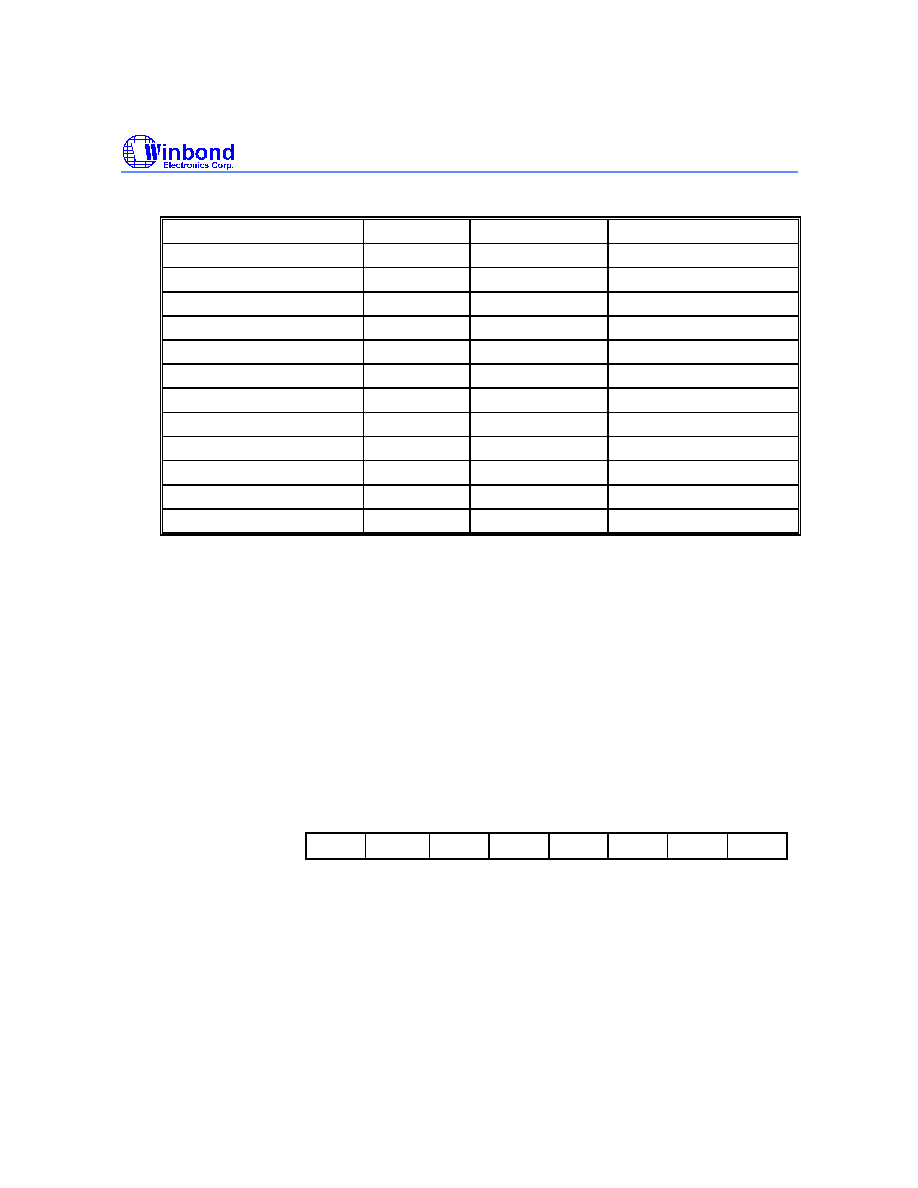
W78C801
- 8 -
Table.1 Priority level for simultaneous requests of the same priority interrupt sources
Source
Flag
Priority level
Vector Address
External Interrupt 0
IE0
(highest)
0003H
External Interrupt 5
IQ5
0053H
Timer 0 Overflow
TF0
000BH
External Interrupt 6
IQ6
005BH
External Interrupt 1
IE1
0013H
External Interrupt 2
IQ2
003BH
External Interrupt 7
IQ7
0063H
Timer 1 Overflow
TF1
001BH
External Interrupt 3
IQ3
0043H
External Interrupt 8
IQ8
006BH
External Interrupt 4
IQ4
004BH
External Interrupt 9
IQ9
(lowest)
0073H
Watchdog Timer
The Watchdog timer is a free-running timer which can be programmed by the user to serve as a
system monitor, a time-base generator or an event timer. It is basically a set of dividers that divide
the system clock. The divider output is selectable and determines the time-out interval. When the
time-out occurs a system reset can also be caused if it is enabled. The main use of the Watchdog
timer is as a system monitor. This is important in real-time control applications. In case of power
glitches or electro-magnetic interference, the processor may begin to execute errant code. If this is
left unchecked the entire system may crash. The watchdog time-out selection will result in different
time-out values depending on the clock speed. The Watchdog timer will de disabled on reset. In
general, software should restart the Watchdog timer to put it into a known state. The control bits that
support the Watchdog timer are discussed below.
Watchdog Timer Control Register
Bit:
7
6
5
4
3
2
1
0
ENW
CLRW
WIDL
-
-
PS2
PS1
PS0
Mnemonic: WDTC
Address: 8FH
ENW : Enable watch-dog if set.
CLRW : Clear watch-dog timer and prescaler if set. This flag will be cleared automatically
WIDL : If this bit is set, watch-dog is enabled under IDLE mode. If cleared, watch-dog is disabled
under IDLE mode. Default is cleared.
PS2, PS1, PS0 : Watch-dog prescaler timer select. Prescaler is selected when set PS2
-
0 as follows:
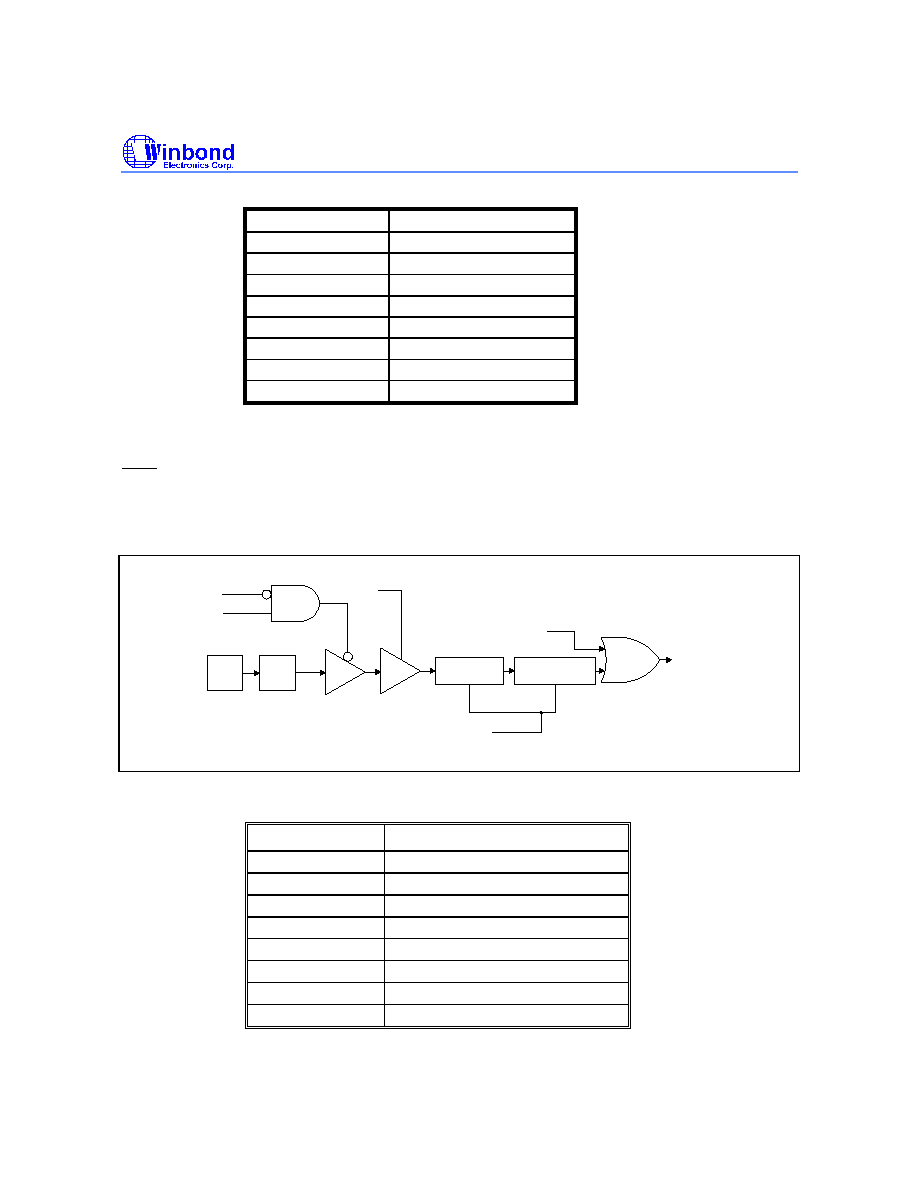
W78C801
Publication Release Date: February 1999
- 9 -
Revision A3
PS2 PS1 PS0
PRESCALER SELECT
0 0 0
2
0 1 0
4
0 0 1
8
0 1 1
16
1 0 0
32
1 0 1
64
1 1 0
128
1 1 1
256
The time-out period is obtained using the following formula:
1
OSC
2
PRESCALER
1000
12 mS
14
◊
◊
◊
◊
Before Watchdog time-out occurs, the program must clear the 14-bit timer by writing 1 to WDTC.6
(CLRW). After 1 is written to this bit, the 14-bit timer , prescaler and this bit will be reset on the next
instruction cycle. The Watchdog timer is cleared on reset.
OSC
1/12
PRESCALER
14-BIT TIMER
CLEAR
CLRW
EXTERNAL
RESET
INTERNAL
RESET
WIDL
IDLE
ENW
Watchdog Timer Block Diagram
Typical Watch-Dog time-out period when OSC = 20 MHz
PS2 PS1 PS0
WATCHDOG TIME-OUT PERIOD
0 0 0
19.66 mS
0 1 0
39.32 mS
0 0 1
78.64 mS
0 1 1
157.28 mS
1 0 0
314.57 mS
1 0 1
629.14 mS
1 1 0
1.25 S
1 1 1
2.50 S

W78C801
- 10 -
Clock
The W78C801 is designed to be used with either a crystal oscillator or an external clock. Internally,
the clock is divided by two before it is used. This makes the W78C801 relatively insensitive to duty
cycle variations in the clock. The W78C801 incorporates a built-in crystal oscillator. To make the
oscillator work, a crystal must be connected across pins XTAL1 and XTAL2. In addition, a load
capacitor must be connected from each pin to ground. An external clock source should be connected
to pin XTAL1. Pin XTAL2 should be left unconnected. The XTAL1 input is a CMOS-type input, as
required by the crystal oscillator.
Power Management
Idle Mode
The idle mode is entered by setting the IDL bit in the PCON register. In the idle mode, the internal
clock to the processor is stopped. The peripherals and the interrupt logic continue to be clocked. The
processor will exit idle mode when either an interrupt or a reset occurs.
Power-down Mode
When the PD bit in the PCON register is set, the processor enters the power-down mode. In this
mode all of the clocks are stopped, including the oscillator. To exit from power-down mode is by a
hardware reset or external interrupts INT2 to INT9 when enabled.
AUXR - Auxiliary Register
Bit:
7
6
5
4
3
2
1
0
-
-
-
-
-
-
-
AO
Mnemonic: AUXR
Address: 8Eh
AO:
Turn off ALE signal.
Reduce EMI Emission
Because of the on-chip ROM, when a program is running in internal ROM space, the ALE will be
unused. The transition of ALE will cause noise, so it can be turned off to reduce the EMI emission if it
is not needed. Turning off the ALE signal transition only requires setting the bit 0 of the AUXR SFR,
which is located at 08Eh. When ALE is turned off, it will be reactivated when the program accesses
external ROM/RAM data or jumps to execute an external ROM code. The ALE signal will turn off
again after it has been completely accessed or the program returns to internal ROM code space.
Reset
The external RESET signal is sampled at S5P2. To take effect, it must be held high for at least two
machine cycles while the oscillator is running. An internal trigger circuit in the reset line is used to
deglitch the reset line when the W78C801 is used with an external RC network. The reset logic also
has a special glitch removal circuit that ignores glitches on the reset line.
During reset, the ports are initialized to FFH, the stack pointer to 07H, PCON (with the exception of
bit 4) to 00H, and all of the other SFR registers except SBUF to 00H. SBUF is not reset.

W78C801
Publication Release Date: February 1999
- 11 -
Revision A3
ABSOLUTE MAXIMUM RATINGS
PARAMETER
SYMBOL
MIN.
MAX.
UNIT
DC Power Supply
V
DD
-
V
SS
-0.3
+6.0
V
Input Voltage
V
IN
V
SS
-0.3
V
DD
+0.3
V
Operating Temperature
T
A
0
70
∞
C
Storage Temperature
T
ST
-55
+150
∞
C
Note: Exposure to conditions beyond those listed under Absolute Maximum Ratings may adversely affect the life and reliability of the
device.
DC CHARACTERISTICS
Vss = 0V ; T
A
= 25
∞
C; unless otherwise specified.
PARAMETER
SYM.
SPECIFICATION
TEST CONDITIONS
MIN.
MAX.
UNIT
Operating Voltage
V
DD
4.5
5.5
V
Operating Current
I
DD
-
20
mA
V
DD
= 5.5V, 16 MHz, no load
Idle Current
I
IDLE
-
6
mA
V
DD
= 5.5V, 16 MHz, no load
Power Down Current
I
PWDN
-
50
µ
A
V
DD
= 5.5V, no load
Input
Input Current
P1, P2, P3, P4
I
IN
-50
+10
µ
A
V
DD
= 5.5V
V
IN
= 0V or V
DD
Input Leakage Current
P0,
EA
I
LK
-10
+10
µ
A
V
DD
= 5.5V
Vss < V
IN
< V
DD
Input Current
RST
I
IN2
-60
+300
µ
A
V
DD
= 5.5V
0 < V
IN
< V
DD
Logic 1-to-0 Transition Current
P1, P2, P3, P4
I
TL
-500
-200
µ
A
V
DD
= 5.5V
V
IN
= 2V
Input Low Voltage
P1, P2, P3, P4
V
IL1
0
0.8
V
V
DD
= 5.5V
Input Low Voltage
RST
V
IL2
0
0.8
V
V
DD
= 5.5V
Input Low Voltage
XTAL1
V
IL3
0
0.8
V
DD
= 5.5V

W78C801
- 12 -
DC Characteristics, continued
PARAMETER
SYM.
SPECIFICATION
TEST CONDITIONS
MIN.
MAX.
UNIT
Input High Voltage
P1, P2, P3, P4
V
IH1
2.4
V
DD
+0.2
V
V
DD
= 5.5V
Input High Voltage
RST
V
IH2
3.5
V
DD
+0.2
V
V
DD
= 5.5V
Input High Voltage
XTAL1
[*4]
V
IH3
3.5
V
DD
+0.2
V
V
DD
= 5.5V
Output
Output Low Voltage
P1, P2, P3, P4
V
OL1
-
0.45
V
V
DD
= 4.5V
I
OL
= +2 mA
Output Low Voltage
P0, ALE, PSEN
[*4]
V
OL2
-
0.45
V
V
DD
= 4.5V
I
OL
= +4 mA
Sink Current
P1, P2, P3
[5]
, P4<0:4>
Isk
1
4
12
mA
V
DD
= 4.5V
V
IN
= 0.45V
Sink Current
P0, ALE, PSEN , P4<5:6>
Isk
2
10
20
mA
V
DD
= 4.5V
V
IN
= 0.45V
Sink Current
P3.4 to P3.7 in High-drive Mode
Isk
3
15
24
mA
V
DD
= 4.5V
V
IN
= 0.45V
Output High Voltage
P1, P2, P3, P4
V
OH1
2.4
-
V
V
DD
= 4.5V
I
OH
= -100
µ
A
Output High Voltage
P0, ALE, PSEN
[*4]
V
OH2
2.4
-
V
V
DD
= 4.5V
I
OH
= -400
µ
A
Source Current
P1, P2, P3, P4<0:4>
Isr1
-120
-250
µ
A
V
DD
= 4.5V
V
IN
= 2.4V
Source Current
P0, ALE, PSEN , P4<5:6>
Isr2
-10
-14
mA
V
DD
= 4.5V
V
IN
= 2.4V
Notes:
*1. RST pin has an internal pull-down.
*2. Pins of P1 and P3 can source a transition current when they are being externally driven from 1 to 0.
*3. RST is a Schmitt trigger input and XTAL1 is a CMOS input.
*4. P0, P2, ALE and
PSEN
are tested in the external access mode.
*5. P3.4 to P3.7 are in normal mode.

W78C801
Publication Release Date: February 1999
- 13 -
Revision A3
AC CHARACTERISTICS
Clock Input Waveform
T
T
XTAL1
F
CH
CL
OP,
T
CP
PARAMETER
SYMBOL
MIN.
TYP.
MAX.
UNIT
NOTES
Operating Speed
F
OP
0
-
16
MHz
1
Clock Period
T
CP
25
-
-
nS
2
Clock High
T
CH
10
-
-
nS
3
Clock Low
T
CL
10
-
-
nS
3
Notes:
1. The clock may be stopped indefinitely in either state.
2. The T
CP
specification is used as a reference in other specifications.
3. There are no duty cycle requirements on the XTAL1 input.
Program Fetch Cycle
PARAMETER
SYMBOL
MIN.
TYP.
MAX.
UNIT
NOTES
Address Valid to ALE Low
T
AAS
1 T
CP
-
-
-
nS
4
Address Hold from ALE Low
T
AAH
1 T
CP
-
-
-
nS
1, 4
ALE Low to
PSEN Low
T
APL
1 T
CP
-
-
-
nS
4
PSEN Low to Data Valid
T
PDA
-
-
2 T
CP
nS
2
Data Hold after PSEN High
T
PDH
0
-
1 T
CP
nS
3
Data Float after PSEN High
T
PDZ
0
-
1 T
CP
nS
ALE Pulse Width
T
ALW
2 T
CP
-
2 T
CP
-
nS
4
PSEN Pulse Width
T
PSW
3 T
CP
-
3 T
CP
-
nS
4
Notes:
1. P0.0
-
P0.7, P2.0
-
P2.7 remain stable throughout entire memory cycle.
2. Memory access time is 3 T
CP
.
3. Data have been latched internally prior to PSEN going high.
4. "
" (due to buffer driving delay and wire loading) is 20 nS.
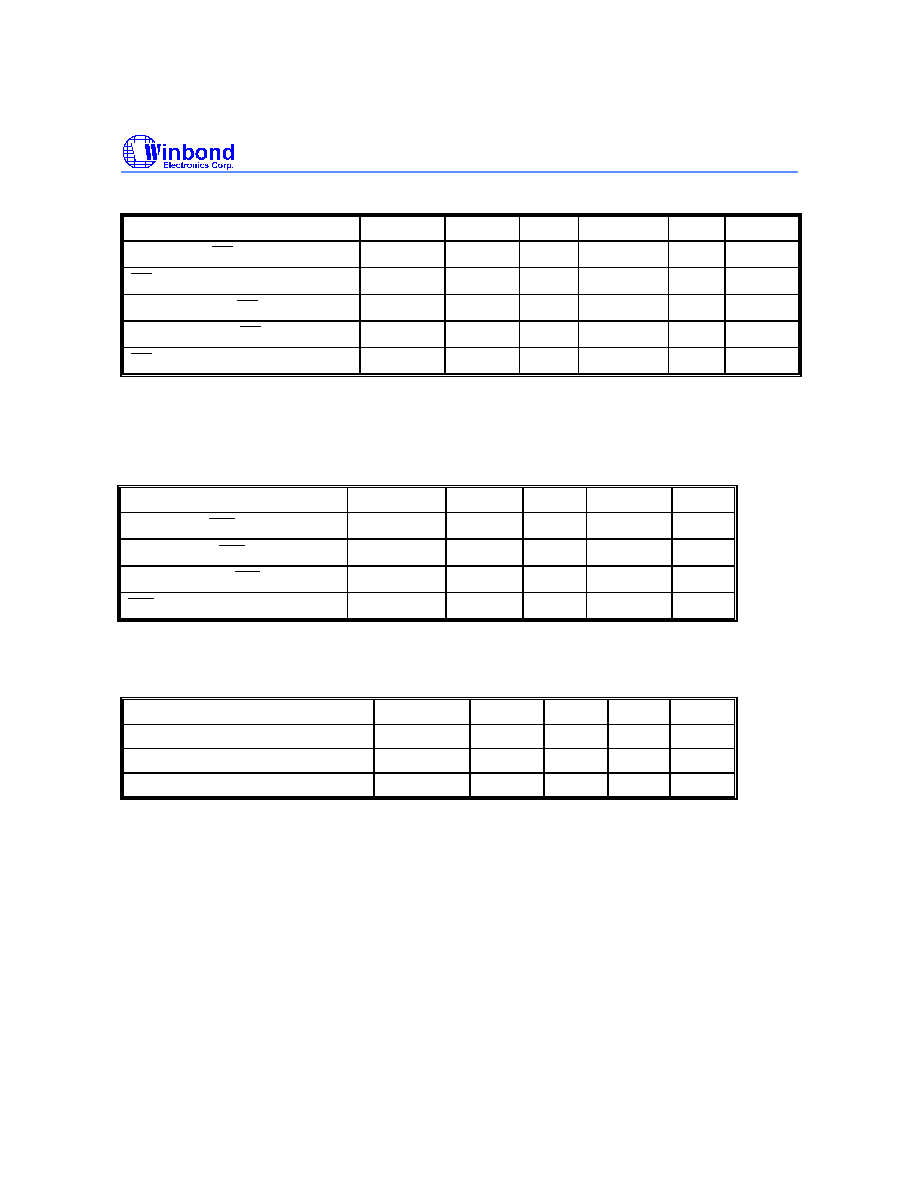
W78C801
- 14 -
Data Read Cycle
PARAMETER
SYMBOL
MIN.
TYP.
MAX.
UNIT
NOTES
ALE Low to RD Low
T
DAR
3 T
CP
-
-
3 T
CP
+
nS
1, 2
RD Low to Data Valid
T
DDA
-
-
4 T
CP
nS
1
Data Hold from RD High
T
DDH
0
-
2 T
CP
nS
Data Float from RD High
T
DDZ
0
-
2 T
CP
nS
RD Pulse Width
T
DRD
6 T
CP
-
6 T
CP
-
nS
2
Notes:
1. Data memory access time is 8 T
CP
.
2. "
" (due to buffer driving delay and wire loading) is 20 nS.
Data Write Cycle
PARAMETER
SYMBOL
MIN.
TYP.
MAX.
UNIT
ALE Low to WR Low
T
DAW
3 T
CP
-
-
3 T
CP
+
nS
Data Valid to WR Low
T
DAD
1 T
CP
-
-
-
nS
Data Hold from WR High
T
DWD
1 T
CP
-
-
-
nS
WR Pulse Width
T
DWR
6 T
CP
-
6 T
CP
-
nS
Note: "
" (due to buffer driving delay and wire loading) is 20 nS.
Port Access Cycle
PARAMETER
SYMBOL
MIN.
TYP.
MAX.
UNIT
Port Input Setup to ALE Low
T
PDS
1 T
CP
-
-
nS
Port Input Hold from ALE Low
T
PDH
0
-
-
nS
Port Output to ALE
T
PDA
1 T
CP
-
-
nS
Note: Ports are read during S5P2, and output data becomes available at the end of S6P2. The timing data are referenced to
ALE, since it provides a convenient reference.
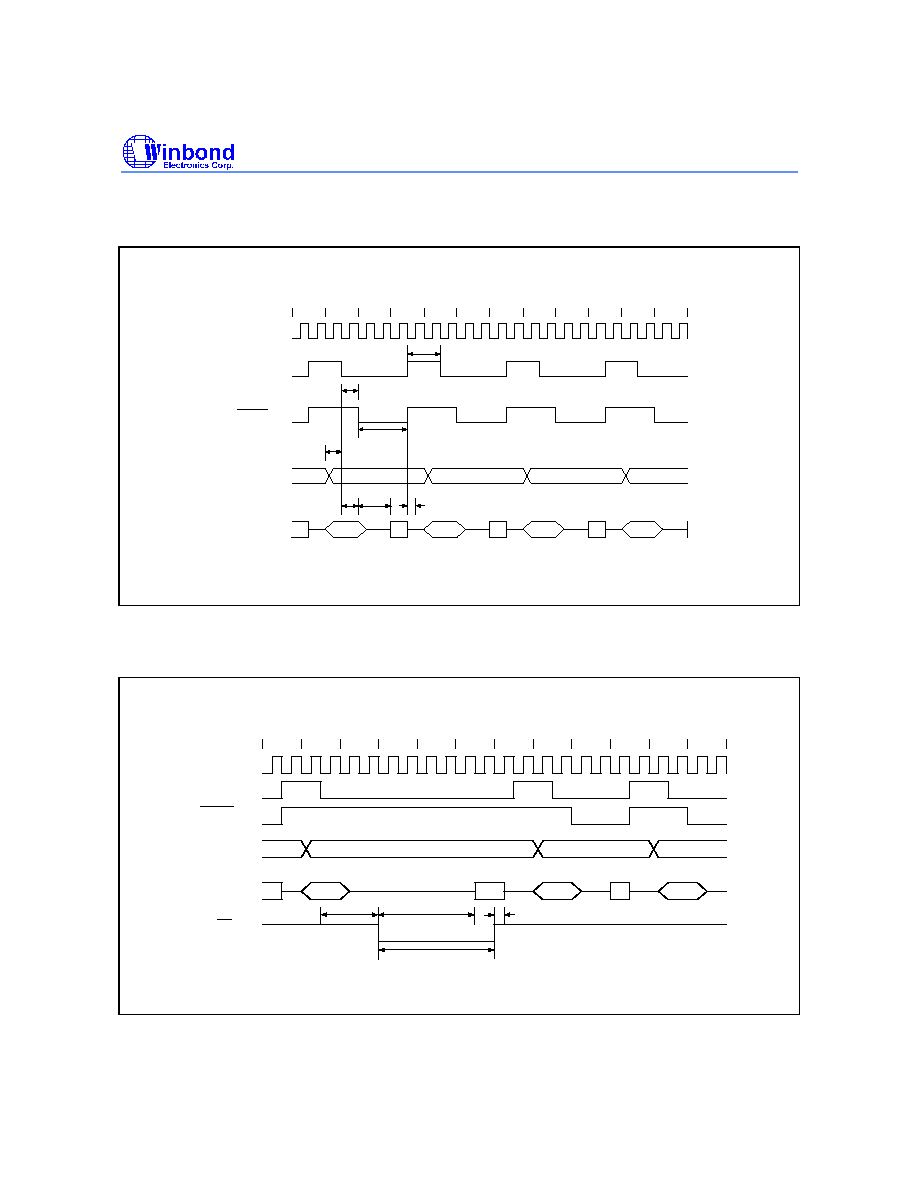
W78C801
Publication Release Date: February 1999
- 15 -
Revision A3
TIMING WAVEFORMS
Program Fetch Cycle
S1
XTAL1
S2
S3
S4
S5
S6
S1
S2
S3
S4
S5
S6
ALE
PORT 2
A0-A7
A0-A7
Data
A0-A7
Code
T
A0-A7
Data
Code
PORT 0
PSEN
PDH,
T
PDZ
T
PDA
T
AAH
T
AAS
T
PSW
T
APL
T
ALW
Data Read Cycle
S2
S3
S5
S6
S1
S2
S3
S4
S5
S6
S1
S4
XTAL1
ALE
PSEN
DATA
A8-A15
PORT 2
PORT 0
A0-A7
RD
T
DDH,
T
DDZ
T
DDA
T
DRD
T
DAR

W78C801
- 16 -
Timing Waveforms, continued
Data Write Cycle
S2
S3
S5
S6
S1
S2
S3
S4
S1
S5
S6
S4
XTAL1
ALE
PSEN
A8-A15
DATA OUT
PORT 2
PORT 0
A0-A7
WR
T
T
DAW
DAD
T
DWR
T
DWD
Port Access Cycle
XTAL1
ALE
S5
S6
S1
DATA OUT
T
T
PORT
INPUT
T
SAMPLE
PDA
PDH
PDS
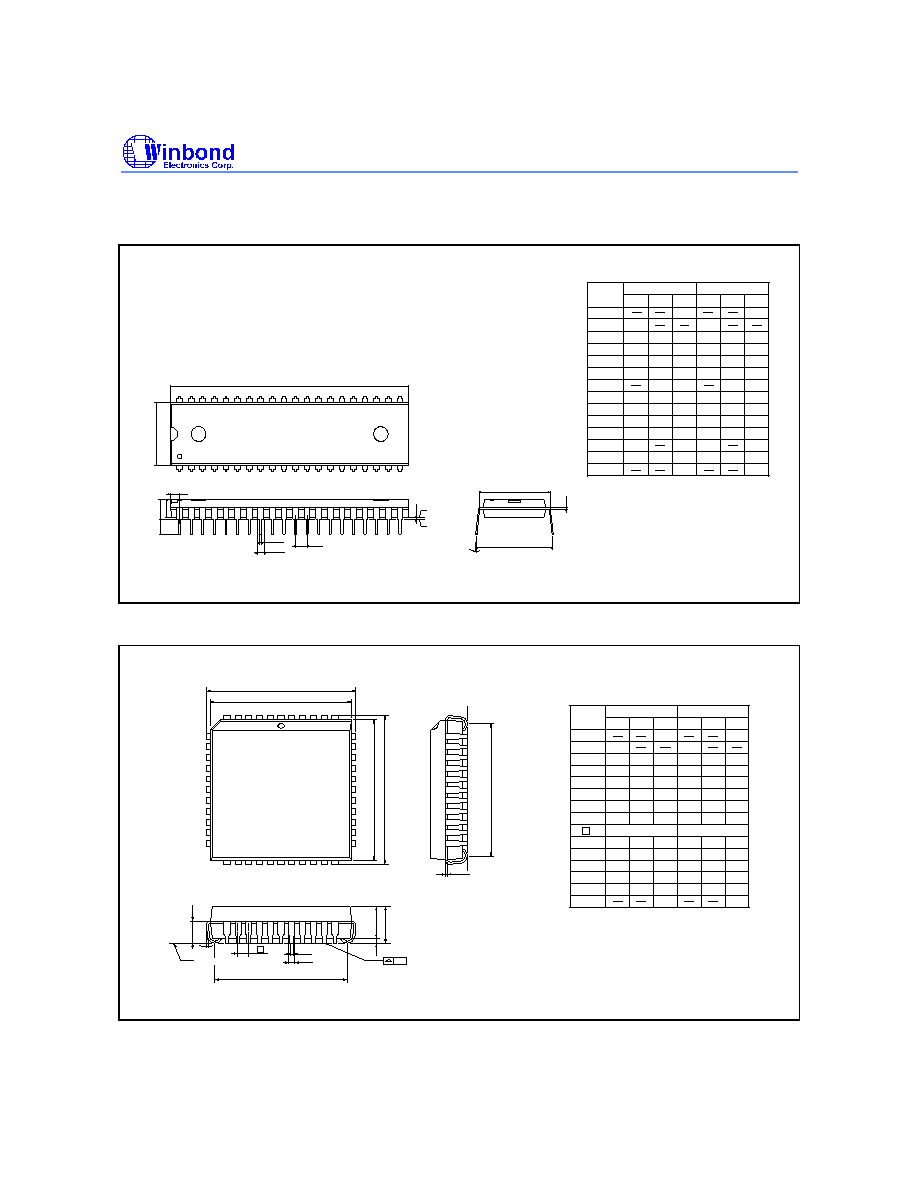
W78C801
Publication Release Date: February 1999
- 17 -
Revision A3
PACKAGE DIMENSIONS
40-pin DIP
Seating Plane
1. Dimension D Max. & S include mold flash or
tie bar burrs.
2. Dimension E1 does not include interlead flash.
3. Dimension D & E1 include mold mismatch and
are determined at the mold parting line.
6. General appearance spec. should be based on
final visual inspection spec.
.
1.372
1.219
0.054
0.048
Notes:
Symbol
Min.
Nom.
Max.
Max.
Nom.
Min.
Dimension in inch
Dimension in mm
0.050
1.27
0.210
5.334
0.010
0.150
0.016
0.155
0.018
0.160
0.022
3.81
0.406
0.254
3.937
0.457
4.064
0.559
0.008
0.120
0.670
0.010
0.130
0.014
0.140
0.203
3.048
0.254
3.302
0.356
3.556
0.540
0.550
0.545
13.72
13.97
13.84
17.01
15.24
14.986
15.494
0.600
0.590
0.610
2.286
2.54
2.794
0.090
0.100
0.110
A
B
c
D
e
A
L
S
A
A
1
2
E
B
1
1
e
E
1
a
2.055
2.070
52.20
52.58
0
15
0.090
2.286
0.650
0.630
16.00
16.51
protrusion/intrusion.
4. Dimension B1 does not include dambar
5. Controlling dimension: Inches.
15
0
e
A
A
a
c
E
Base Plane
1
A
1
e
L
A
S
1
E
D
1
B
B
40
21
20
1
2
44-pin PLCC
44
40
39
29
28
18
17
7
6
1
L
c
1
b
2
A
H
D
D
e
b
E
H
E
y
A
A
1
Seating Plane
D
G
G
E
Symbol
Min. Nom.
Max.
Max.
Nom.
Min.
Dimension in inch
Dimension in mm
A
e
H
E
L
y
b
c
D
A
A
1
2
E
b
1
H
D
G
G
D
E
Notes:
on final visual inspection spec.
4. General appearance spec. should be based
3. Controlling dimension: Inches
protrusion/intrusion.
2. Dimension b1 does not include dambar
flash.
1. Dimension D & E do not include interlead
0.020
0.145
0.026
0.016
0.008
0.648
0.590
0.680
0.090
0.150
0.028
0.018
0.010
0.653
0.610
0.690
0.100
0.050
BSC
0.185
0.155
0.032
0.022
0.014
0.658
0.630
0.700
0.110
0.004
0.508
3.683
0.66
0.406
0.203
16.46
14.99
17.27
2.296
3.81
0.711
0.457
0.254
16.59
15.49
17.53
2.54
1.27
4.699
3.937
0.813
0.559
0.356
16.71
16.00
17.78
2.794
0.10
BSC
16.71
16.59
16.46
0.658
0.653
0.648
16.00
15.49
14.99
0.630
0.610
0.590
17.78
17.53
17.27
0.700
0.690
0.680

W78C801
- 18 -
Package Dimensions, continued
44-pin PQFP
Seating Plane
11
22
12
See Detail F
e
b
A
y
1
A
A
L
L
1
c
E
E
H
1
D
44
H
D
34
33
Detail F
1. Dimension D & E do not include interlead
flash.
2. Dimension b does not include dambar
protrusion/intrusion.
3. Controlling dimension: Millimeter
4. General appearance spec. should be based
on final visual inspection spec.
0.254
0.101
0.010
0.004
Notes:
Symbol
Min.
Nom.
Max.
Max.
Nom.
Min.
Dimension in inch
Dimension in mm
A
b
c
D
e
H
D
H
E
L
y
A
A
L
1
1
2
E
0.006
0.152
---
0.002
0.075
0.01
0.081
0.014
0.087
0.018
1.90
0.25
0.05
2.05
0.35
2.20
0.45
0.390
0.025
0.063
0.003
0
7
0.394
0.031
0.398
0.037
9.9
0.80
0.65
1.6
10.00
0.8
10.1
0.95
0.398
0.394
0.390
0.530
0.520
0.510
13.45
13.2
12.95
10.1
10.00
9.9
7
0
0.08
0.031
0.01
0.02
0.25
0.5
---
---
---
---
---
2
0.025
0.036
0.635
0.952
0.530
0.520
0.510
13.45
13.2
12.95
0.051
0.075
1.295
1.905
Headquarters
No. 4, Creation Rd. III,
Science-Based Industrial Park,
Hsinchu, Taiwan
TEL: 886-3-5770066
FAX: 886-3-5792697
http://www.winbond.com.tw/
Voice & Fax-on-demand: 886-2-7197006
Taipei Office
11F, No. 115, Sec. 3, Min-Sheng East Rd.,
Taipei, Taiwan
TEL: 886-2-7190505
FAX: 886-2-7197502
Winbond Electronics (H.K.) Ltd.
Rm. 803, World Trade Square, Tower II,
123 Hoi Bun Rd., Kwun Tong,
Kowloon, Hong Kong
TEL: 852-27513100
FAX: 852-27552064
Winbond Electronics North America Corp.
Winbond Memory Lab.
Winbond Microelectronics Corp.
Winbond Systems Lab.
2727 N. First Street, San Jose,
CA 95134, U.S.A.
TEL: 408-9436666
FAX: 408-5441798
Note: All data and specifications are subject to change without notice.

















